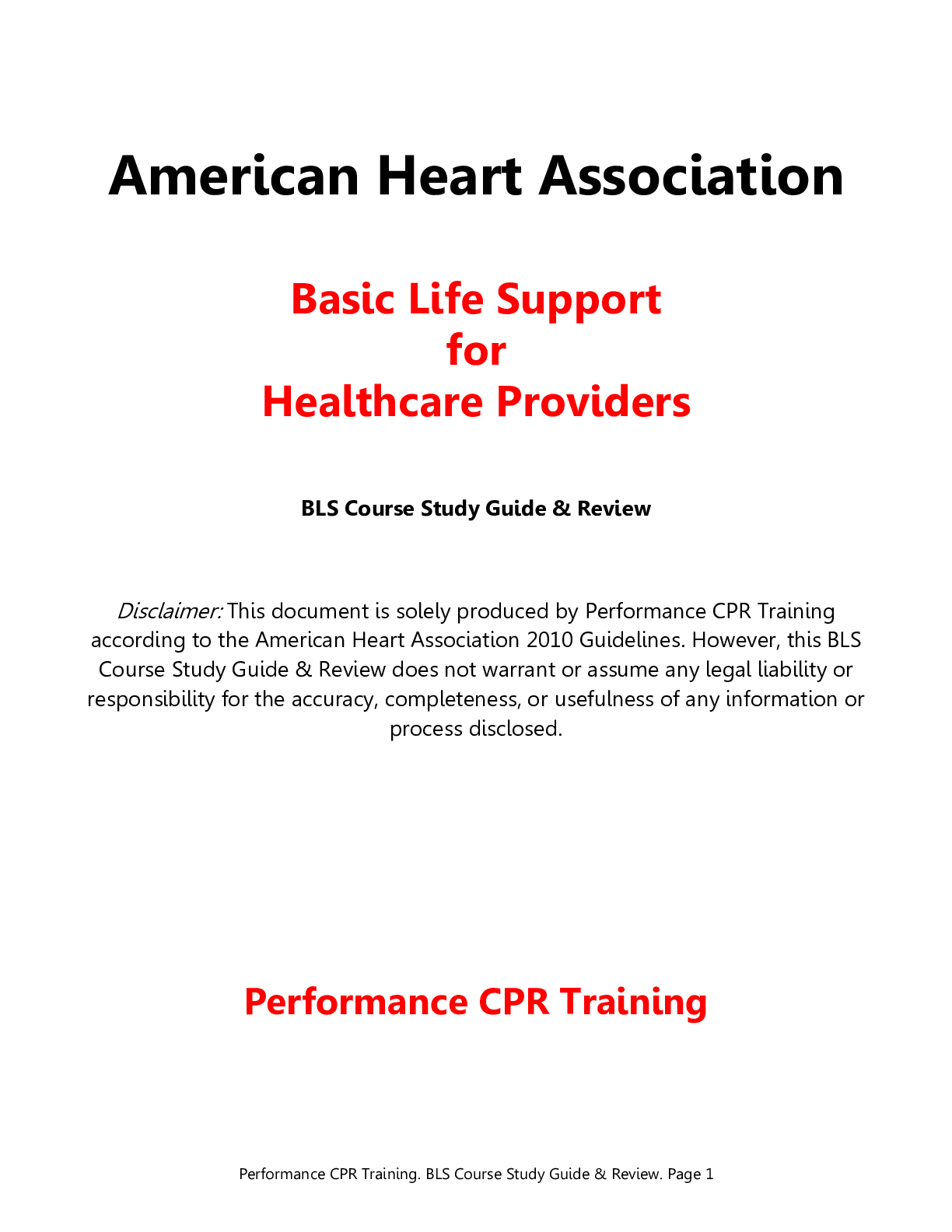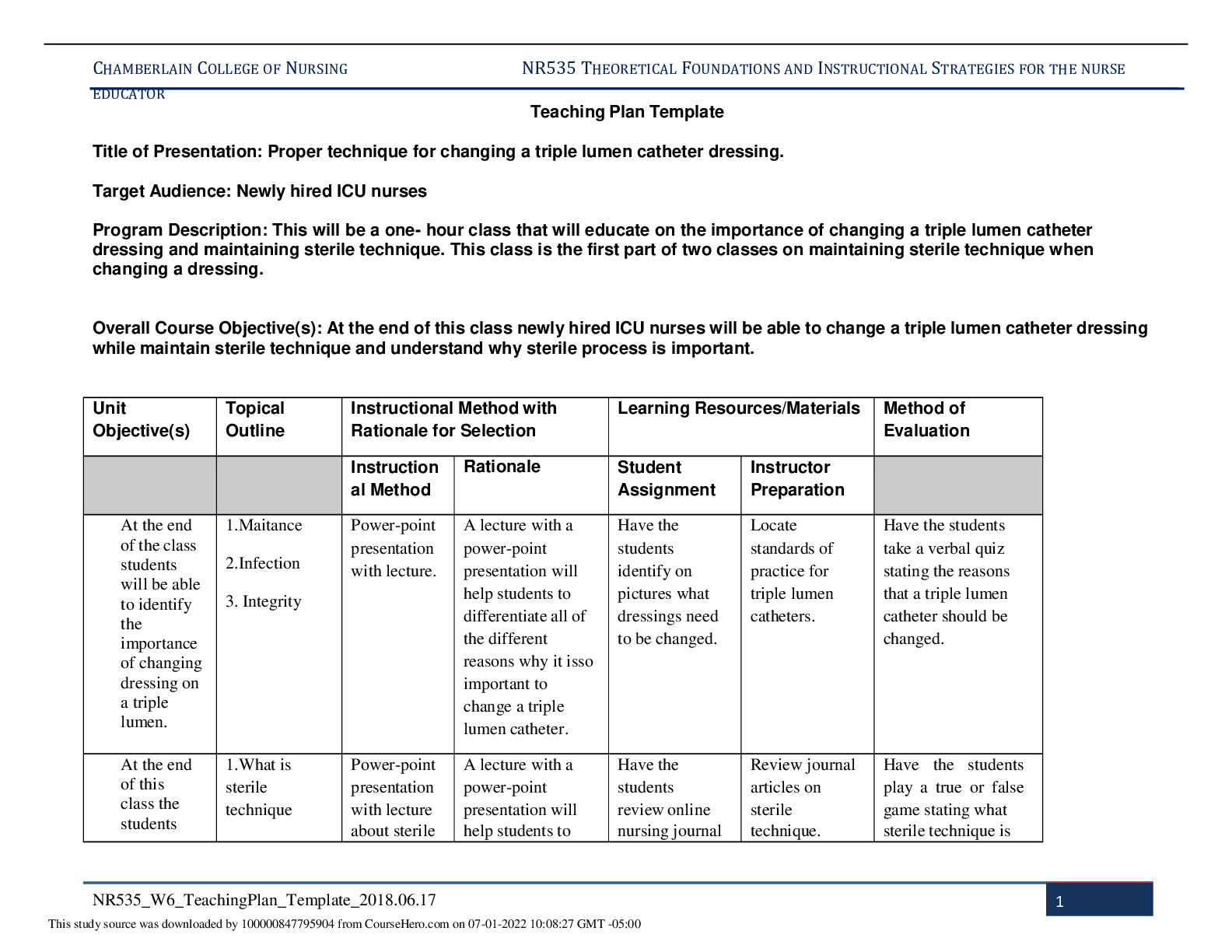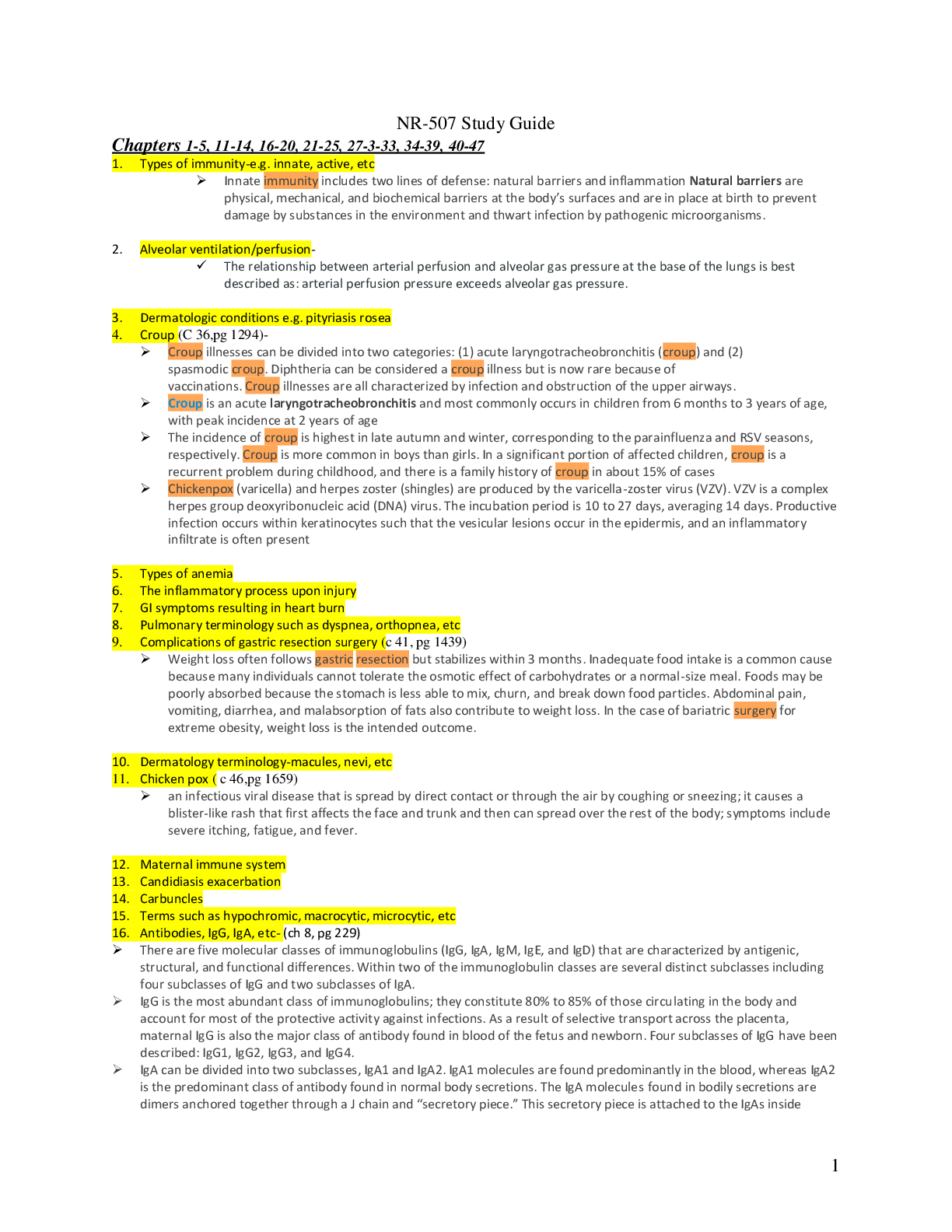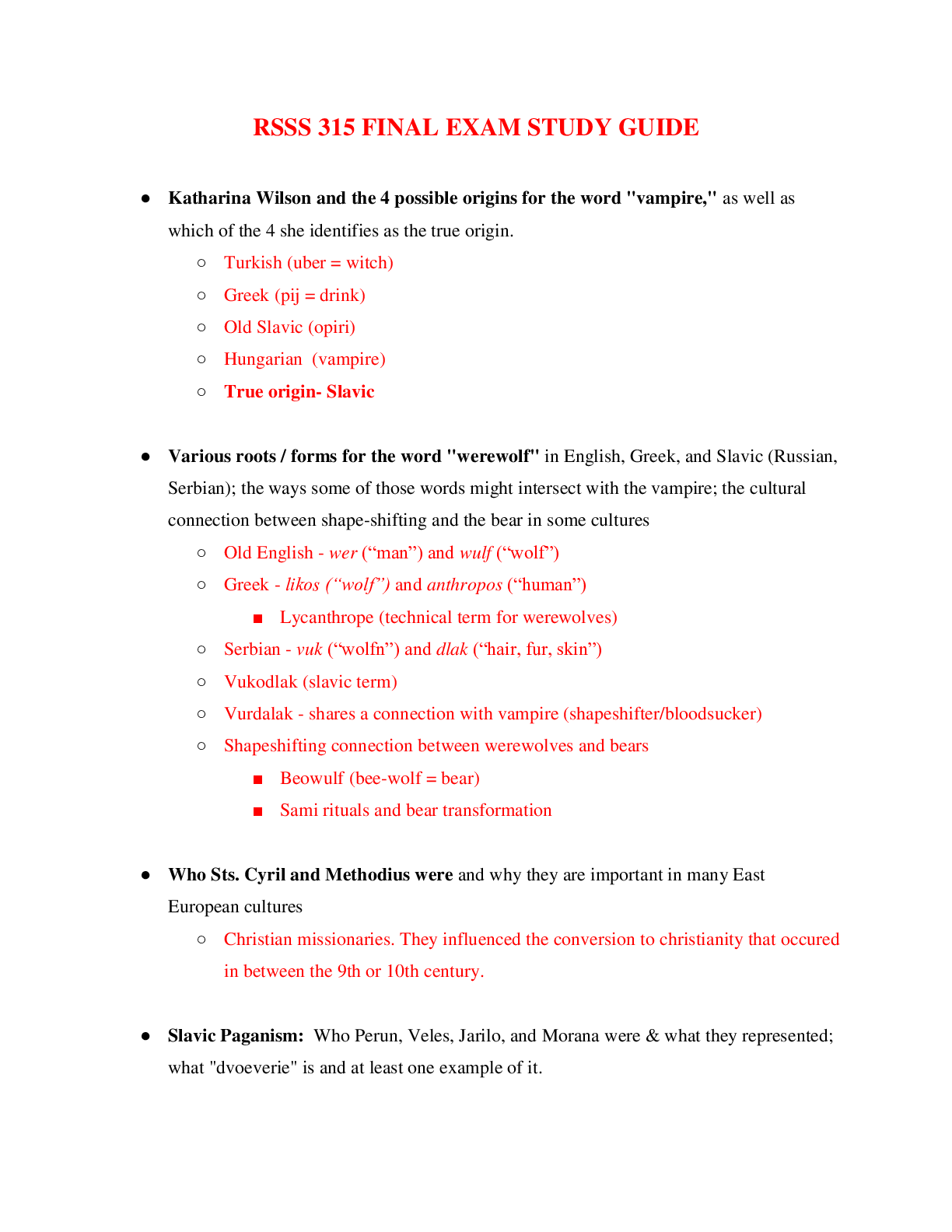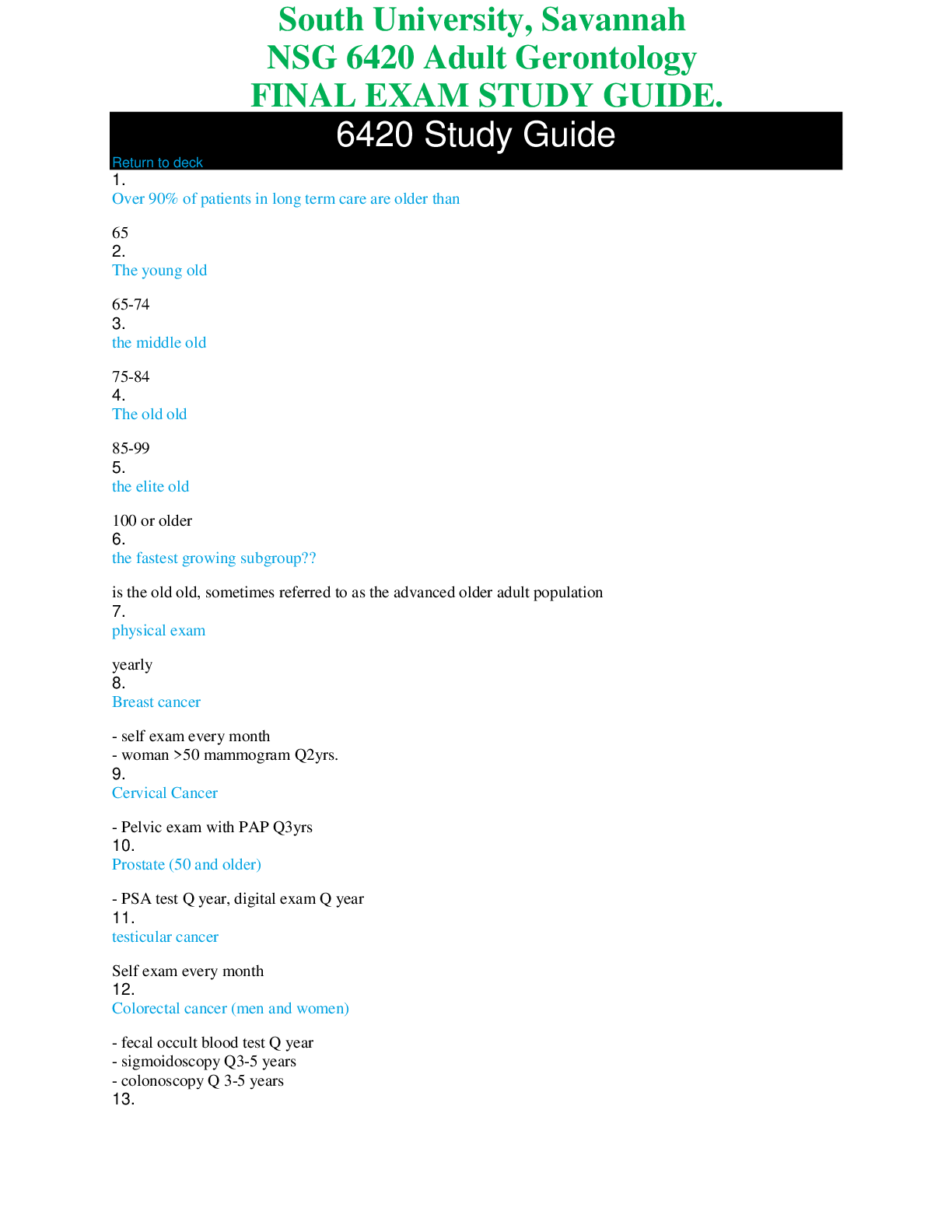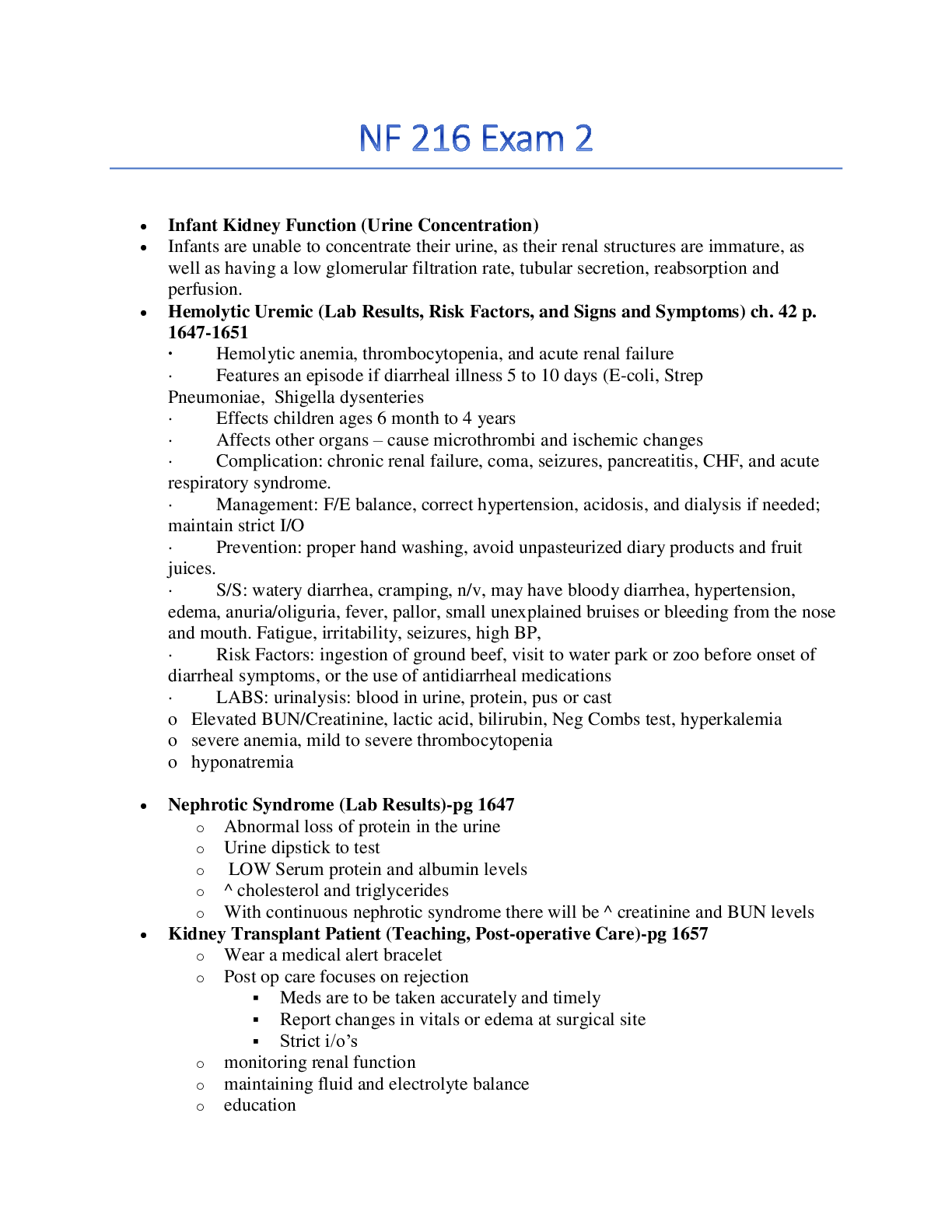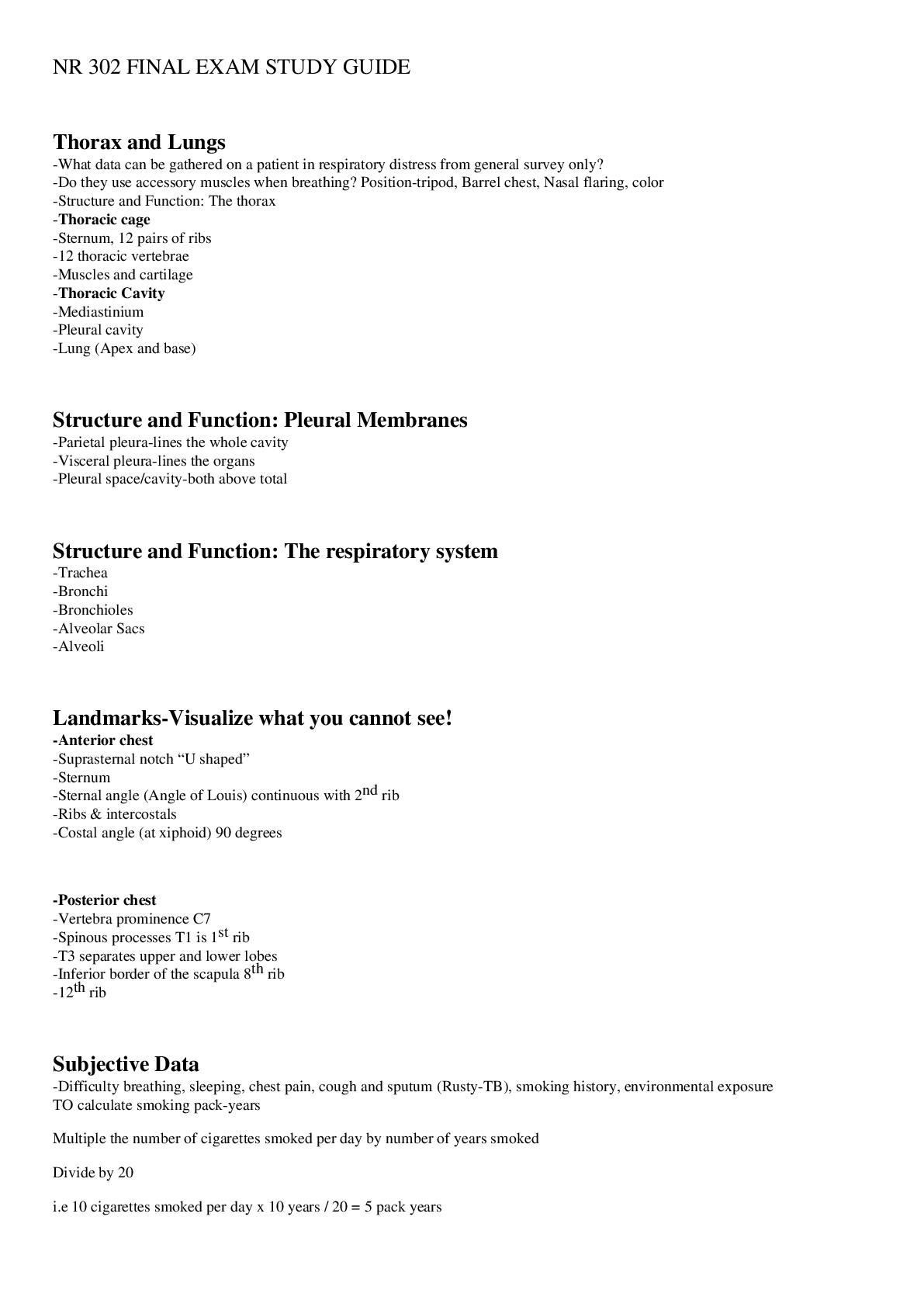*NURSING > STUDY GUIDE > Nasm CPT Final Exam Study Guide (All)
Nasm CPT Final Exam Study Guide
Document Content and Description Below
Proprioception The body's ability to to sense the relative position of adjacent parts of the body Ex: when walking our feet give us proprioception about the type of surface we are on. Mechano... receptors specialized structures that recognize pressure in tissue and transmit signals to sensory nerves. Muscle Spindles sensory receptors in the muscles that are parallel to the muscle fibers and are sensitive to change in muscle length. Spindles stretch with muscle and sends information to CNS. helps to prevent muscles from stretching too far or too fast Golgi Tendon Organs sensory receptors that are located at the point where the skeletal muscle fibers insert into the tendon. Sensitive to change in tension at the rate of change causes the muscle to relax Epimysium connective tissue UNDER fascia that acts as an outer layer of the whole muscle Perimysium connective tissue acts as an outer layer of fascicles Endomysium between the individual muscle fibers Type 1 Muscle Fiber "slow-twitch", smaller in size, lessforce produced, long-term contractions (stabilization) Type 2 Muscle Fiber fast twitch, larger, quick to fatigue, force and power exercises Agonist PRIME MOVER, main muscles ex: chest press-> pectoralis major Synergist ASSIST PRIME MOVER, ex: chest press -> ant deltoid, triceps Stabilizer stabilizes while prime mover and assist work. chest press -> rotator cuff Antagonist Oppose Prime mover, chest press -> posterior delt Right Atrium gather DEOXGENATED blood returning to the heart from ENTIRE BODY Left Atrium gathers OXYGENATED blood coming from the LUNGS Right Ventricle thin walls pumps under low pressure. Pumps to lungs Left Ventricle thick walls, pumps under high pressure to rest of body Metabolism all of the chemical reactions that happen in our body to maintain itself. Nutrients are acquired, transported and used by the body. Exercise Metabolism bioenergetics as it relates to the unique physiologic changes and demands on body during exercise Substrates where enzymes act Carbohydrates Sugars, starches, and fiber. Provide the body with a source of fuel and energy required for all daily activities Glucose a simple sugar that comes from the digestion of carbs that is transported through the blood and is used or stored as energy Glycogen the stored form of carbs, when needed it converts to glucose and used Fat a secondary source of energy Trigylcerides come from fats, when calories are consumed but not used they are converted and stored in fat cells Protein Amino acids that build and repair body tissues and structures. A third energy source, usually not until starvation. Recommended 0.8 g per day Adults, 1.2-1.7 per day strength athletes, 1.2-1.4 endurance athletes 1 g = 4 calories Gluconeogenesis glucose form from non carb sources like amino acids Adenosine Triphosphate (ATP) Energy storage and transfer unit in the cells. When chemical bonds that hold it together are broken, energy is released Adenosine Diphosphate (ADP) molecule produced by ATP ATP-PC system simpliest and fastest, occurs without oxygen (anaerobic), provides energy for high intensity, short-duration ex: power and strentgh Glycosis System produces lots of energy for 30-50 sec. Typical bc it falls in the time frame of 8-12 reps Oxidative System most complex B- oxidation breakdowns triclgycerides into free fatyy acids to produce more ATP Myth of Fat Burning Zone higher intensity workouts require greater contribution from fat despite the increase in need of fuel source from carbs Biomechanics internal and external forces acting on the human body and the effect produced Superior above a reference point inferior below a reference point Proximal reference closest to the center of the body or reference Distal refernence furthest away Anterior Reference in front of the body Posterior Reference in the back of the body Medial Refernence to the midline of the body Lateral Reference to the outside of the body Contralateral refers to a position on the opposite side of the body Ipsilateral positioned on the same side of the body Sagittal Plane movements of flexion or extension ex: front lunge, bicep curls, squat Frontal Plane movements lateral ex: side lunge, side lat raises Transverse Plane divides body in upper and lower halves Adduction movement TOWARD the midline of the body Abduction movement AWAY from the midline of the body Isotonic Constant muscle tension ex: eccentric, concentric Isometric constant muscle length isokinetic The speed of movement is fixed. Usually seen in Rehab facilities Force characterized by how much and direction, influenced applied by one object to another. Torque a force that produces rotation Training Zone 1 walking or jogging; Builds aerobic base and aids in recovery Maximal HR x .65 (.75) Training Zone 2 Group Exercise classes, spinning; Increases Aerobic and Anerobic Endurance Maximal HR x .76 (.85) Training Zone 3 Sprinting; Builds high end work capacity Maximal HR x .86 (.96) Estimated Maximal Heart Rate 220- age Body Mass Index weight proportional to height BMI= [weight (lbs)/height (inchxinch)] x 703 YMCA 3 minute Step Test 96 steps per minute for 3 minutes. Record HR for 60 sec and locate recovery pulse on chart and determine which training zone Rockport Walk Test clients walks a mile on treadmill and HR and time are recorded after. Use formula Pronation Distortion Syndrome (ASHA) Short muscles: gastrocnemius, soleus, adductors, hip flexor complex, biceps femoris Long muscles: anterior and posterior tibilias, vastus medium, gluteus medius-maximus, hip external rotators increased knee adduction, knee internal rot, foot pronation Injuries: plantar faciitis, shin splits, patellar tendonitis, low back pain Lower Crossed Syndrome (high butt) Short muscles: gastr, soleus, hip flexor, adductors, lattismus dorsi, erector spinae Long muscles: ant/pos tibilias, glutes max/med, tranversus ab, internal oblique anterior knee pain, low back injuries Upper Crossed Syndrome (hunch back) short muscles: upper traps, sternocleidomastoid, lattismus dorsi, teres major, pec major/minor long muscles: rhomboids, mid traps, lower traps, teres minor, scapular elevation and dec shoulder extension and rotation Overhead Squat Assessment sit the height of a chair, arms and elbows fully extended above head. The tibia and torso should be in line Comps: low back arch, inward knees, flat feet, forward lean, arms fall forward ( 5 reps) Single Leg Squat Assessment does knee adduct and internally rotate (5 each leg) Pushing Assessment does low back arch, shoulders elevate, head move forward? (20 reps) Pulling assessment same as pushing assessment (20 reps) Push up Test muscular endurance of the upper body (60 sec) Davies Test measure upper extremity agility and stabilization. Alteranate touching the opposite hand (15 seconds) Shark Skill Test measures lower extremity agility and coordination. clients hops in each box single legged, and will have time added if hands come off hips, other leg touches ground, wrong square, does not go back to center. Upper Extremity test: Bench warm up light 8-10 reps add weight perform 3-5 reps, rest, and increase weight Lower Extremity test: Squat ... Flexibility the ability to move a joint through its complete range of motion Extensibility Soft tissues ability to be elongated or stretched Dynamic ROM combination of flexibility and the nervous system's ability to control the rom effficiently Neuromuscular Efficiency the ability of the nervous system to recruit the correct muscles (agonist, antagonist, synergist, and stabilizers) to produce force (concentric), reduce force (eccentric), and dynamically stabilize (isometric) the body in all 3 planes of motion. Postural Distortion Patterns Predictable patterns of muscle imbalances Relative Flexibility the body's tendency to seek the path of least resistance Muscle Imbalance Alteration of muscle length surrounding a joint Cause: postural stress, repetitive movement, lack of core strentgh Reciprocal Inhibition simultaneous contraction of one muscle and the relaxation of its ANTAGONIST EX: Bicep curls- biceps brachii contract while triceps brachii relaxes Altered Reciprocal Inhibition a tight AGONIST causes a decrease in the function of it ANTAGONIST EX: tight hip flexor (psoas) would decrease neural drive of the hip extensor (gluteus maximus) Synergistic Dominance when the synergist take over for a weak prime mover. May cause faulty movement patterns EX: tight hip flexor -> decrease glute -> increase force from synergist (hamstring complex, adductor magnus). Arthrokinematics motion of the joints Arthrokinetic Dysfunction biomechanical and neuromuscular dysfuction leading to altered joint motion Autogentic Inhibition occurs when the neural impulses sensing tension are greater than the impulses causing muscle contraction Pattern Overload constantly repeating the same pattern of motion, which could place abnormal stress on the body Davis's Law states that soft tissue models along the lines of stress Static Stretching traditional; the process of passively taking a muscle to the point of tension and holding the stretch for a minimum of 30 seconds. Active- Isolated Stretch suggested for pre-activity warm up; process of using agonist and synergist to dynamically move the joint into range of motion. 5- 10 reps/ 1-2 seconds Dynamic Stretching uses the force production and the momentum of the body to take a joint through the full ROM ex: prisoner squates, multiplanar lunges Myofascial Release (FOAM ROLL) by applying gentle force to a knot the muscle fibers are altered from a bundled bunch to a straighter line. Cardiorespiratory Fitness The ability of the respiratory system to supply oxygen-rich blood to skeletal muscles during physical activity Integrated cardiorespiratory training planned training programs that improve physiological, physical, and performance adaptations Intensity The level of demand that a given activity places on the body Maximal Oxygen Consumption the highest rate of oxygen transport and utilization achieved at maximal physical exertion FITTE Frequency, Intensity, Time, Type, Enjoyment Overtraining excessive volume and a lack of proper rest and recovery Drawing-in-maneuver used to recruit the local core stabilizers by drawing the navel in toward the spine Bracing when the abdomin, lower back, and butt muscles are all contracted at the same time Local Stabilization System provides support from vertebrae to vetebrae EX: Transversus abdominis, internal oblique, pelvic floor muscles, diaphragm Global Stabilization System muscles that attach from the pelvic to the spine, transfer loads between upper and lower extremities. Ex: Psoas MAjor, external oblique, portions of internal oblique, gluteus medius, adductor complex Core- Stabilizing Exercises marching, floor bridge, prone cobra, prone iso abs (plank): Regressions- push up position, push up position w/ knees down, hands on bench feet on ground Core- Strength Exercises Ball Crunch (progress: raise arms overhead), back extensions, reverse crunch, cable rotation Core- Power Exercises Rotation Chest pass, medball pulloverthrow, Front MB oblique throw, soccer throw Rate of force production ability of muscles to exert maximal force output in a minimal amount of time. Plyometric Training quick,powerful exercises phases: eccentric (loading), amortization (dynamic stabilization), concentric (unloading) Speed the ability to move the body in one direction as fast as possible Stride Rate number of strides in a given time Stride Length the distance covered with each stride Frontside Mechanics proper alignment of leading leg and pelvis, dorsiflexed ankle, knee flexion, hip flexion,and neutral pelvis Backside Mechanics Proper alignment, ankle plantarflexion, hip extension, knee extension, neutral pelvis Agility ability to accelerate, decelerate, stabilize, and change direction quickly while maintaining posture Quickness the ability to react and change body position with maximal rate of force in all planes of motion General Adaptation Syndrome (GAS) how the body responds and adapts to stress Stages: Alarm Reaction, Resistance DEvelopment, Exhaustion Specific adaptation to imposed demands (SAID) Principle states that the body will adapt to the specific demands being placed on it Acute Variables important components that specify how each exercise is to be performed Training Volume AMOUNT of physical training performed in a specified period. Training Frequency number of training sessions performed during a specific period (usually 1 week) Training Duration timeframe from the start of the workout to the end OR length of time (weeks) spent in one phase of training Nutrition process by which a living organism assimilates food and uses it for growth and repair of tissues Calorie expression of energy, equal to 1,000 calories Essential Amino Acids 1. Isoleucine 2. Leucine 3. Lysine 4.Methionine 5. Phenylalanine 6. Threonine 7. Tryptophan 8. Valine Types of Carbohydrates Monosaccharide: single sugar units connected to make glucose Disaccharides 2 sugar units (sucrose [sugar], lactose[milk] Polysaccharides: longs chains of mono. Complex carbs(starch/fiber) Daily recommendation for Fiber 38 g/day -> young men, 25 g/day -> young women Fatty Acids Saturated: risk for heart disease, raise bad cholesterol Unsaturated: increase good cholesterol Monounsaturated: ONE double bond, olive & canola oil Polyunsaturated: >One double bond, cold water fish Lipids (Fats) most concentrated energy source. 1 g = 9 calories preserve body heat, regulate nutrients in cells, protects organs, prolonges digestion Water consumption Recommendations men= 3.0 L (13 cups) daily women = 2.2 L (9 cups) daily (add 8 ounces of water for every 25 lbs over ideal weight) Altering Body Composition: FAT LOSS < 10% of calories from sat fats, increase physical activity, dec food and bev calories, limit alcohol, 4-6 meals a day, avoid processed food Altering Body Composition: LEAN MASS postworkout window- ingest protein and carbs within 90 minutes, spread protein throughout the day, 4-6 meals a day Ergogenic Aids enhances athletic performance. Creatine- Typical dosage 20 grams per day for 5-7 days then 2-5 grams per day for maintenance. Increase in 4-5 lbs, maintenance safe for 2-5 years Ex: Creatine, builds muscle mass, strentgh, and anerobic performance. Stimulants Stages of change Maintenance, Action, Preparation, Contemplation, Precontemplation SMART goals Specific: detailed description of goal Measurable: quantifiable goals Attainable: right mix that are challenging but in reach Realistic: the individual truly believes it can be done Timely: A specific date of completion Cognitive Strategies aim to change a client's thoughts and attitudes toward exercise and physical activity Positive Self-Talk help clients come up with a positive list pertaining to exercise Exercise Imagery the process created to produce internalized experience to support [Show More]
Last updated: 11 months ago
Preview 1 out of 28 pages
Instant download

Buy this document to get the full access instantly
Instant Download Access after purchase
Add to cartInstant download
Reviews( 0 )
Document information
Connected school, study & course
About the document
Uploaded On
Jul 22, 2023
Number of pages
28
Written in
Additional information
This document has been written for:
Uploaded
Jul 22, 2023
Downloads
0
Views
49











